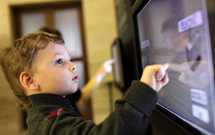As learning becomes more self-directed, informal learning is gaining popularity
 Learning is changing. It is moving from a primarily school-based, formal process to include more informal opportunities. Learning is just as likely to occur among a group of students at a coffee shop or at a museum as it is within a virtual group on a social network.
Learning is changing. It is moving from a primarily school-based, formal process to include more informal opportunities. Learning is just as likely to occur among a group of students at a coffee shop or at a museum as it is within a virtual group on a social network.
Informal learning, then, is often characterized by its impromptu and unofficial nature, as a new infographic demonstrates.
Today’s students must be independent workers, able to collaborate and solve problems, and informal learning supports these skills because it requires autonomy, flexibility, accessibility, and relevance.
The 2013 New Media Consortium K-12 Horizon Report identified informal learning as a challenge, noting that K-12 education systems “must address the increased blending of formal and informal learning.”
(Next page: Experts discuss informal learning)
More traditional forms of education, including lectures and testing, are still dominant in schools today, the Horizon report notes.
However, “in order for students to get a well-rounded education with real world experience, they must also engage in more informal in-class activities as well as experience learning outside the classroom. In most schools, students are not encouraged to do this.”
The growing popularity of informal learning experiences, however, is prompting many education leaders to identify solutions to this challenge.
Many adults today say they have learned many of their skills and much of their knowledge through informal learning experiences.
These experiences, then, can extend to today’s K-12 students in a combination of formal and informal learning. Through informal learning, students are often more engaged in their experiences.
Research is increasingly investigating how informal learning impacts students and how it might be bridged with formal learning.
For instance, the National Science Foundation’s Advancing Informal STEM Learning program offers grants to “support research into how learning happens outside the classroom, exploring the most effective practices and building the evidence base in this area.”
Supporting learning in informal settings using digital technology is an important and timely question–a concept panelists discussed during a webinar on informal learning hosted by the Smithsonian Center for Learning and Digital Access.
“My research is centered around what we are calling interest-driven learning,” said Kylie Peppler, assistant professor for the Learning Sciences Program at Indiana University in Bloomington. “Just to recap, it is about kids having an interest and letting that drive them through the work. How do we develop those kinds of interests, how do we link that to the formal settings, are some of the most challenging questions we have today.”
Research suggests that students can use their own interests to put them on learning pathways that will help them develop skills and knowledge.
Peppler’s work involves music education and how to pique students’ interest in that subject. Using RockBand as a pathway helps students perform better on traditional music education, such as reading and writing music.
“A lot of times what we can do is capitalize on youth culture,” Peppler said. “This might be the video games they play or it might be whatever is happening that they are interested in, and how can we leverage that as a pathway through [to learning]?”
Another example lies in MIT’s programming language SCRATCH.
“It’s a good example of how leveraging youth media and culture transformed computer programming,” Peppler said. “Kids that are really reluctant and have never wanted or had an interest in computer programming, for example, all of a sudden are not just creating one or two projects, but a huge portfolio of projects.
“It’s really transformative to think about how can we merge youth culture with the kinds of things that we value today.”
In order to take advantage of informal learning and open up those pathways, educators have to go beyond just bringing youth culture into the classroom–they have to “remix” it so that students’ interests are intertwined with engaging learning experiences.
“[Informal learning involves creating] a bridge so we can capitalize on what’s really familiar to them, the technologies that are really important to them in their youth circles, and the kinds of experiences we’d like to have for them in the museum setting, in the online setting, in the game setting,” Peppler said.
“We need to reform schools to get more interest-driven learning in schools,” said Mark Warschauer, professor of education and informatics at the University of California, Irvine. He is also the Associate Dean of the Irvine School of Education.
So some of the things that we want to do in school settings are more interest driven learning, engaging learning, autonomous learning, increasing levels of challenges, opportunities to learn from mentors, we’re working on that in schools but we absolutely need to do it in out-of-school settings…So I think if we can use out of school learning opportunities, museums and other informal ways to try and develop interest driven opportunities for kids, that would be a great opportunity.”
Museums are especially well-poised as informal learning centers because they have collections, scientists or artists, educators, and digital resources, said Claudine Brown, assistant secretary for Education and Access for the Smithsonian.
Challenges remain when it comes to integrating informal learning with formal learning. Panelists mentioned the Young Writers Project and the Chicago Summer of Learning as just two examples of how formal and informal learning might work together.
But when the two do come together, students are immersed in engaging and powerful learning experiences.
- Educators love their edtech, but want more training - April 18, 2024
- Friday 5: College and career readiness - April 12, 2024
- Cybersecurity: eSN Innovation Roundtable - April 11, 2024

